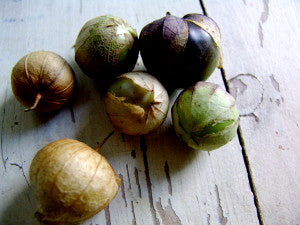 Often this summer the lunch conversation has turned to, "Would you take a bite out of a tomatillo?" Then answer generally splits our staff into two camps -- those who would dare and those who would never. Tomatillos are an interesting fruit that have a flavor that, when eaten raw, can be off putting to some, er, most. However, when blended with other ingredients, the tomatillo turns into a rich, sweet back drop that enhances flavors.
Often this summer the lunch conversation has turned to, "Would you take a bite out of a tomatillo?" Then answer generally splits our staff into two camps -- those who would dare and those who would never. Tomatillos are an interesting fruit that have a flavor that, when eaten raw, can be off putting to some, er, most. However, when blended with other ingredients, the tomatillo turns into a rich, sweet back drop that enhances flavors.
For us, in zone 6A, peak tomatillo season is now. This is the time when the fruits lighten in color and the the husks dry, signalling that the starches have converted into sugars, making them quite sweet. With the abundance that even a single plant can bring, the peak of tomatillo season can be a bit intimidating. Just how should you prepare them?
 My advice? Prepare them for the entire winter! As popular opinion would suggest, a sauce or salsa is the best way to enjoy tomatillos. Though canning salsa is not recommended without a pressure canner, cooked salsas freeze extremely well, releasing bits of summer with every thawed pint. As for the ingredients, I've found that the simpler the ingredients list, the better, and roasted until toasted is the ultimate.
My advice? Prepare them for the entire winter! As popular opinion would suggest, a sauce or salsa is the best way to enjoy tomatillos. Though canning salsa is not recommended without a pressure canner, cooked salsas freeze extremely well, releasing bits of summer with every thawed pint. As for the ingredients, I've found that the simpler the ingredients list, the better, and roasted until toasted is the ultimate.
Roasted Tomatillo Salsa
I call this a salsa but you can also use it as a sauce for enchilladas or smothered burritos. There is no real measurement here, make this as hot or garlicky as you want.
Ingredients:
Tomatillos
Lots of garlic: peeled but left whole
Hot peppers: Serranos are great, as well as Lemon Drop
Salt
Limes
Cilantro
1. Preheat oven to 400 degrees. Line a sheet pan with parchment paper. (Or more as needed.)
2. Prepare the tomatillos. Remove the husks from the tomatillos and rinse.
3. Arrange tomatillos shoulder side down on prepared sheet pan. Be sure to leave space between the fruits. Lay peppers and garlic cloves in empty spaces.
4. Roast for about 20 minutes, checking after about 10 minutes or so. or until peppers and tomatillos are brown and blistered.
5. Remove from oven and place in food processor or blender. Pulse a few times, remove lid and add lime juice and salt to taste. Add fresh cilantro leaves and place lid back on. Pulse until cilantro is chopped up and the sauce is pureed to your liking. Make final adjustments with lime juice and salt.
6. TO FREEZE: Let cool, ladle into pint jars, leaving 1 inch or so at the time. I do not recommend using a larger jar because once the salsa thaws you have to use it up! Take care using glass, only use jars recommended for freezing and do not over fill. Label and date the jars, then place in freezer. To use: let thaw on the container for 5 hours, or thaw the day before in the refrigerator.





